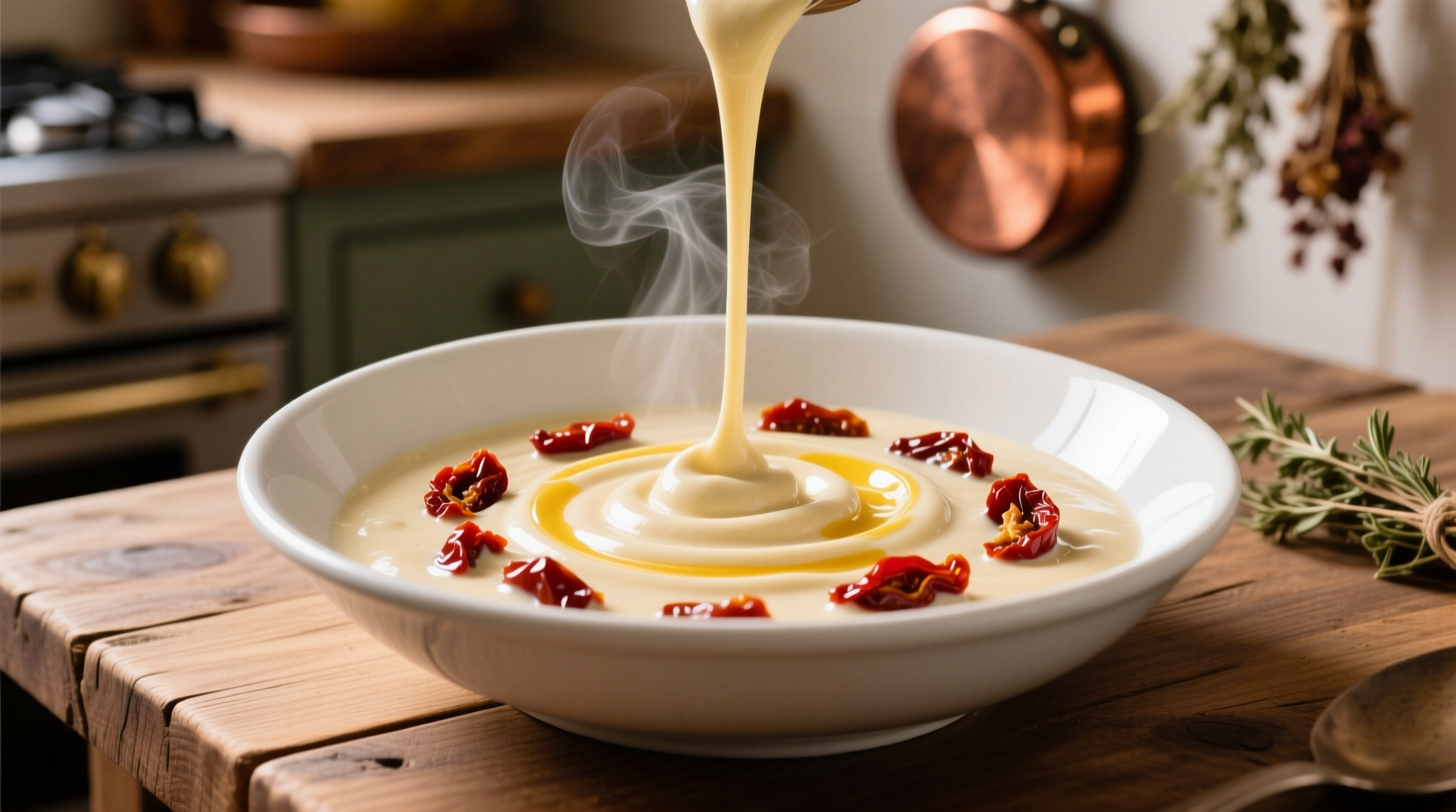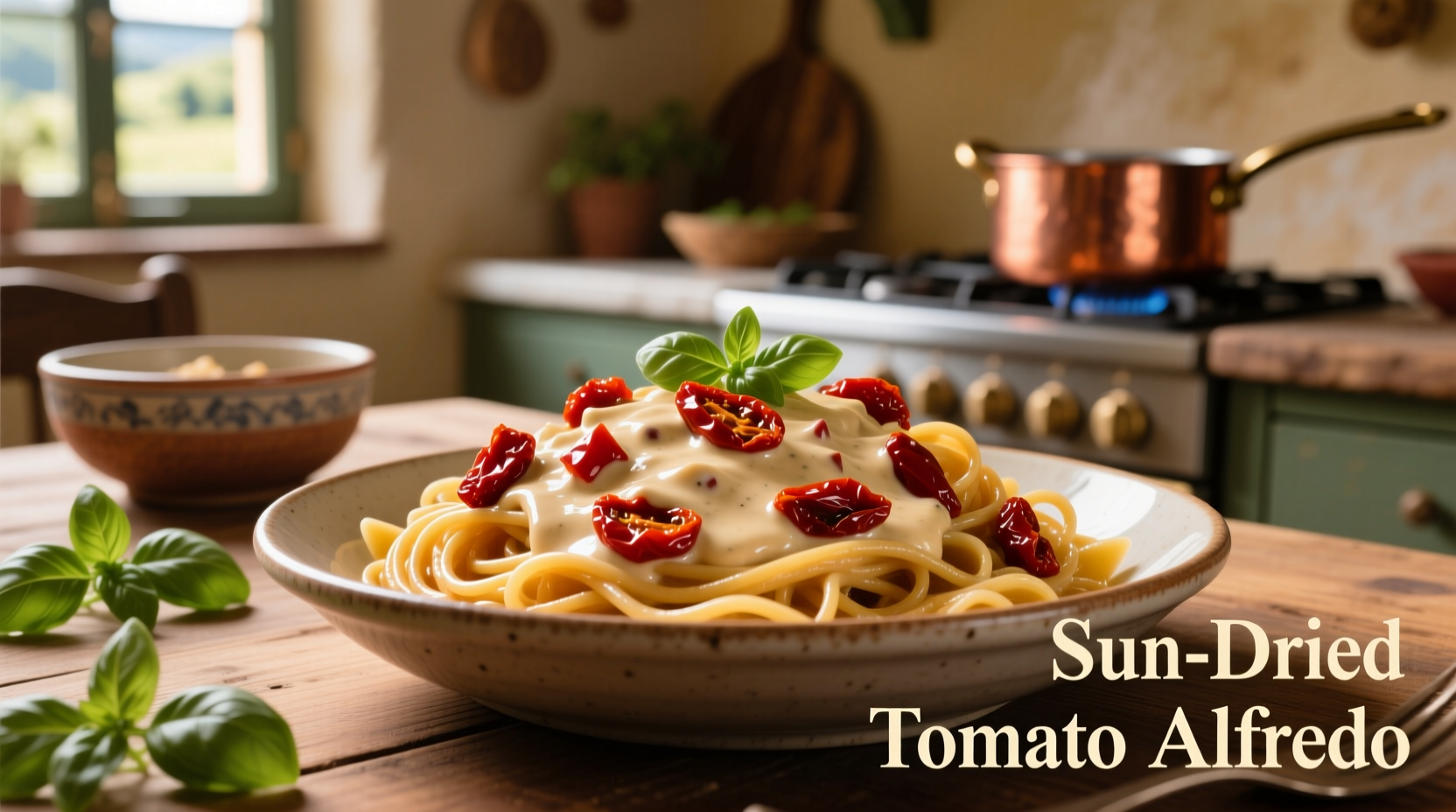Transform your weeknight dinners with this restaurant-quality sun dried tomato alfredo sauce recipe that delivers vibrant flavor in just 25 minutes. Forget store-bought versions with artificial ingredients—our chef-tested method creates a velvety, deeply flavorful sauce with the perfect balance of creamy richness and sun-dried tomato intensity. Whether you're cooking for family or preparing an impressive date night meal, this guide gives you everything needed to master this popular Italian-inspired sauce.
Why Sun Dried Tomato Alfredo Stands Out
While traditional alfredo relies solely on butter, cream, and Parmesan for its luxurious texture, sun dried tomato alfredo introduces a complex flavor dimension through concentrated tomato essence. The sun-drying process removes moisture while intensifying natural sugars and umami compounds, creating a flavor profile that's simultaneously sweet, tangy, and deeply savory. This variation maintains the comforting creaminess of classic alfredo while adding sophisticated depth that elevates simple pasta dishes into restaurant-worthy creations.
| Feature | Traditional Alfredo | Sun Dried Tomato Alfredo |
|---|---|---|
| Primary Flavor Profile | Creamy, buttery, cheesy | Creamy with sweet-tart tomato complexity |
| Color | Pale ivory | Rich coral-pink |
| Preparation Time | 15 minutes | 20-25 minutes |
| Flavor Complexity | Mono-dimensional richness | Layered sweet, tangy, savory notes |
| Best Pasta Pairings | Fettuccine, linguine | Penne, rigatoni, farfalle |
Ingredient Selection: Building Flavor Foundations
The quality of your ingredients directly determines your sauce's final character. For authentic sun dried tomato alfredo sauce, pay special attention to these components:
Sun-Dried Tomatoes: The Flavor Catalyst
Choose between oil-packed or dry-packed varieties based on your desired flavor intensity:
- Oil-packed tomatoes offer immediate usability and contribute subtle olive oil notes to your sauce
- Dry-packed tomatoes require 15-20 minute rehydration but deliver more concentrated tomato flavor
According to the USDA National Nutrient Database, sun-dried tomatoes contain approximately 257% more lycopene than fresh tomatoes due to the concentration effect of drying, enhancing both nutritional value and flavor depth.
Cheese Selection: Beyond Basic Parmesan
While Parmesan forms the essential base, consider these professional enhancements:
- Substitute 25% of Parmesan with Pecorino Romano for added complexity
- Use freshly grated cheese—pre-grated versions contain anti-caking agents that prevent smooth melting
- Maintain a 1:4 cheese-to-cream ratio for optimal texture
Step-by-Step Preparation Guide
Follow this chef-approved method for perfectly balanced sun dried tomato alfredo sauce:
Essential Equipment
- Medium heavy-bottomed saucepan
- Immersion blender or standard blender
- Microplane grater for cheese
- Wooden spoon for stirring
Proper Sun-Dried Tomato Preparation
For dry-packed tomatoes: Soak in warm water with 1 teaspoon sugar for 15-20 minutes until pliable. Drain thoroughly, reserving ¼ cup soaking liquid. For oil-packed tomatoes: Drain excess oil but retain 1 tablespoon for added flavor dimension. This preparation method maximizes flavor extraction while preventing sauce separation.
Sauce Assembly Technique
- Melt 2 tablespoons butter over medium-low heat
- Add 2 minced garlic cloves, sauté until fragrant (30 seconds)
- Add prepared sun-dried tomatoes and ½ cup cream
- Simmer 5 minutes to meld flavors
- Blend until completely smooth using immersion blender
- Return to pan, gradually whisk in remaining 1½ cups cream
- Reduce heat to low, gradually incorporate 1 cup grated cheese
- Cook 3-5 minutes until thickened to coating consistency

Contextual Application Guide
Sun dried tomato alfredo sauce performs exceptionally well in specific culinary contexts while having limitations in others:
Ideal Applications
- Pasta dishes: Works best with ridged or curved pastas that capture sauce (penne, rigatoni, farfalle)
- Protein accompaniments: Complements grilled chicken, shrimp, or salmon beautifully
- Veggie boosters: Pairs well with roasted vegetables like asparagus, zucchini, or artichoke hearts
Limitations to Consider
- Avoid using with delicate seafood like scallops that might be overwhelmed
- Not recommended for lasagna layers due to potential separation during baking
- May clash with strongly flavored ingredients like blue cheese or anchovies
Serving & Storage Recommendations
For optimal flavor development, let your sauce rest 5 minutes after preparation before serving. Toss with freshly cooked pasta and a splash of pasta water to help the sauce adhere properly. This sauce maintains best quality when consumed immediately but can be stored properly:
- Refrigeration: Store in airtight container for up to 4 days
- Reheating: Warm gently over low heat with a splash of cream or milk
- Freezing: Not recommended as dairy-based sauces may separate upon thawing
Troubleshooting Common Issues
Even experienced cooks encounter challenges with creamy sauces. Here's how to address frequent problems:
Sauce Too Thin
Create a slurry with 1 teaspoon cornstarch mixed with 1 tablespoon cold cream. Whisk into simmering sauce until thickened. Avoid adding more cheese, which can make the sauce grainy.
Sauce Too Thick
Gradually incorporate warm cream or reserved pasta water, 1 tablespoon at a time, until desired consistency achieved. Never use cold liquid as it may cause separation.
Grainy Texture
This occurs when cheese is added to excessively hot liquid. Solution: Remove sauce from heat before adding cheese, and use low-moisture, freshly grated varieties. If already grainy, blend with 1-2 ice cubes to restore smoothness.
Professional Flavor Enhancement Tips
Elevate your sun dried tomato alfredo with these chef-approved techniques:
- Add ¼ teaspoon red pepper flakes during garlic sauté for subtle heat
- Finish with fresh basil or parsley for brightness
- Incorporate 1 tablespoon nutritional yeast for deeper umami notes
- Use roasted garlic instead of raw for mellower flavor profile
Frequently Asked Questions
Can I make sun dried tomato alfredo sauce dairy-free?
Yes, create a dairy-free version using cashew cream (soaked cashews blended with water) as the base, nutritional yeast for cheesy flavor, and coconut milk for richness. The sun-dried tomatoes provide enough acidity to balance the creaminess without dairy.
How do I prevent my alfredo sauce from separating?
Maintain low heat throughout preparation, never boiling the sauce. Add cheese off-heat and incorporate gradually. Use freshly grated cheese without anti-caking agents. If separation occurs, blend with 1-2 ice cubes to re-emulsify the sauce.
What's the difference between sun-dried tomato alfredo and regular alfredo?
Sun-dried tomato alfredo incorporates rehydrated sun-dried tomatoes that add sweet-tart complexity and vibrant color, while traditional alfredo relies solely on butter, cream, and Parmesan for its flavor profile. The tomato version has greater flavor dimension and pairs better with robust ingredients.
Can I use fresh tomatoes instead of sun-dried?
Fresh tomatoes lack the concentrated flavor of sun-dried varieties. If substituting, roast 2 cups cherry tomatoes at 375°F until caramelized, then reduce further in the sauce. The flavor profile will be milder and less complex than authentic sun-dried tomato alfredo.











 浙公网安备
33010002000092号
浙公网安备
33010002000092号 浙B2-20120091-4
浙B2-20120091-4